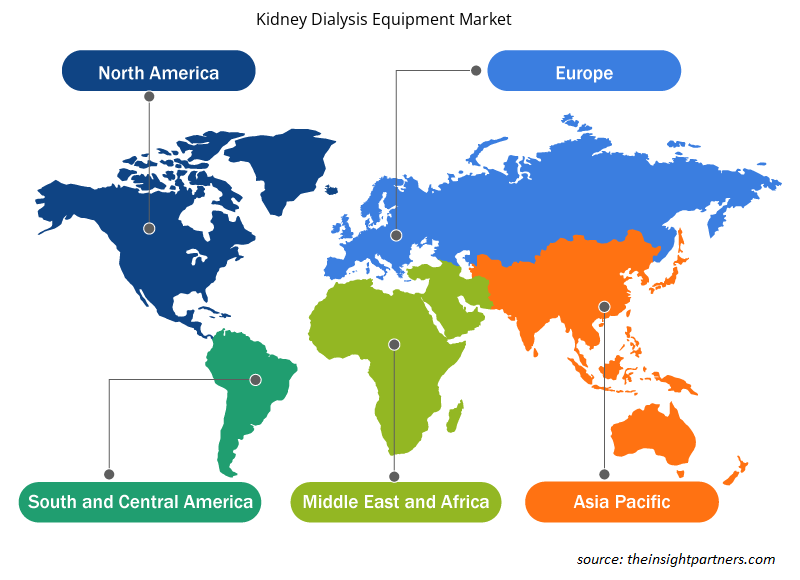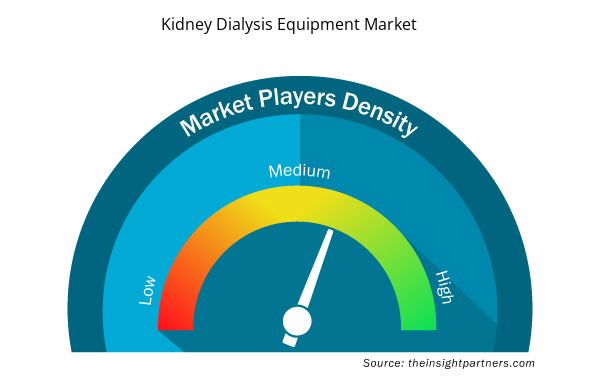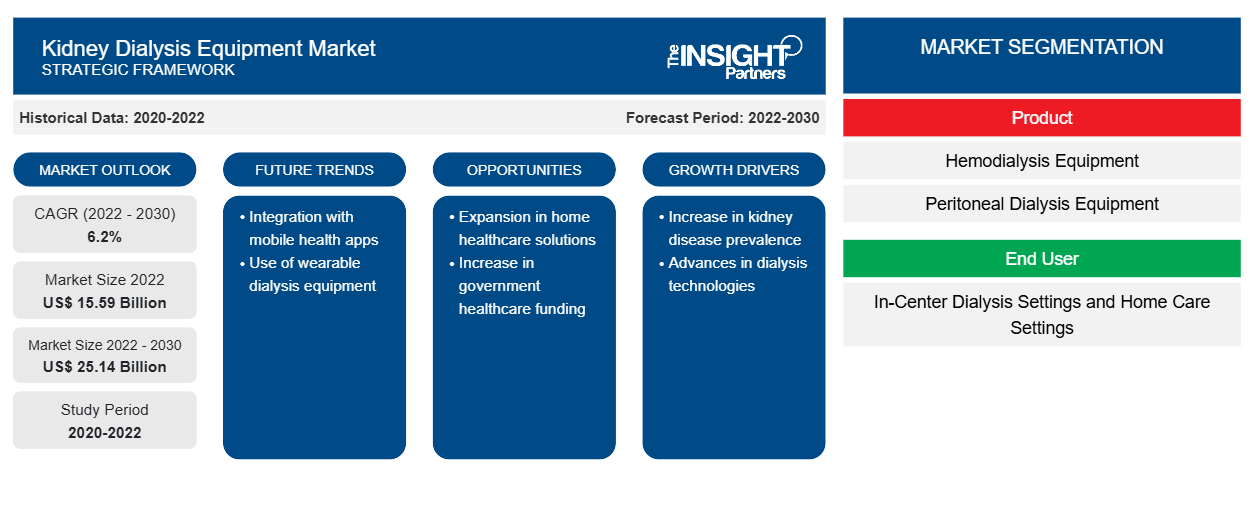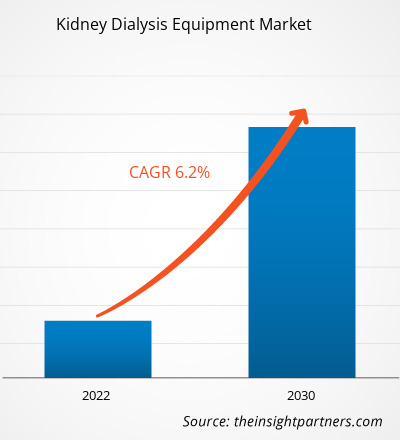[研究报告] 2022年肾透析设备市场价值为155.9亿美元,预计到2030年将达到251.4亿美元;预计2022-2030年期间的复合年增长率为6.2%。
市场洞察和分析师观点:
肾透析设备市场 预测是根据各种二手和一手研究来源(例如主要公司出版物、协会数据和数据库)的结果进行估算的。
肾透析设备用于治疗患有慢性肾病的患者。该设备包括透析器,当肾脏无法充分发挥其功能时,透析器可过滤掉废物以及多余的血液。慢性肾病 (CKD) 患病率的激增、大量老年人接受透析以及发达国家医疗报销额的增加推动了对肾透析设备的需求。然而,高昂的设备成本和严格的监管框架阻碍了肾透析设备市场的增长。
影响肾透析设备市场的驱动因素和限制因素
肾衰竭已成为近年来最突出的死亡原因之一。根据 2022 年 4 月在 ScienceDirect 上发表的一篇文章,CKD 是一种渐进性疾病,影响全球 10% 以上的人口,代表超过 8 亿人。随着年龄的增长,人们由于与年龄相关的疾病(例如高血压和糖尿病)而更容易患上肾脏疾病。透析是一种挽救生命的治疗方法,当肾脏无法正常运作时,它有助于清除血液中多余的液体和废物。透析设备是管理肾功能受损患者所必需的。随着全球老龄人口的增加以及被诊断患有 CKD 或终末期肾病 (ESRD) 的患者数量的激增,对血液透析机、透析器和透析浓缩液等透析设备的需求预计将大幅增加。因此,受高血压、肥胖、糖尿病和人口老龄化等决定因素推动,CKD 患病率不断上升,将推动 2022-2030 年肾透析设备市场规模的增长。
新兴市场趋势
机器设计和技术的进步使制造商能够开发创新高效的透析设备。现代设备产品可提高患者的舒适度、改善治疗效果并缩短治疗时间。透析设备中使用消毒技术、一次性透析器和改进的水净化系统有助于降低感染风险。此外,人们开始转向家庭透析治疗,这导致对便携式和可穿戴透析机的需求增加。越来越多的数字技术公司正在进入医疗保健领域,以帮助提高透析设备的可及性,特别是用于远程治疗肾脏疾病。例如,2023 年 6 月,AWAK Technologies 与新加坡中央医院 (SGH) 合作启动了自动可穿戴人工肾腹膜透析 (AWAK PD) 设备的前枢纽临床试验。AWAK PD 是一种可穿戴的超便携系统,使医疗保健提供者能够在家中或任何舒适的地方为终末期肾病患者进行透析。 2021 年 3 月,Fresenius Medical Care North America (FMCNA) 和 DaVita Kidney Care 扩大了协议,在美国提供家庭透析解决方案。该产品线包括 NxStage 家庭血液透析 (HHD) 机器、透析用品和联网健康平台。该协议旨在让更多慢性肾衰竭患者选择家庭透析,从而改善他们的生活质量。
因此,预计此类现代透析技术将在未来几年带来新的肾透析设备市场趋势。
定制此报告以满足您的需求
您可以免费定制任何报告,包括本报告的部分内容、国家级分析、Excel 数据包,以及为初创企业和大学提供优惠和折扣
- 获取此报告的关键市场趋势。这个免费样品将包括数据分析,从市场趋势到估计和预测。
报告细分和范围:
“肾透析设备市场分析”通过考虑以下细分市场进行
:
产品和最终用户。根据产品,市场分为血液透析和腹膜透析设备。根据最终用户,市场分为中心透析环境和家庭护理环境。
节段分析:
按产品划分,肾透析设备市场分为血液透析设备和腹膜透析设备。血液透析设备部分在 2022 年占据了更大的市场份额,预计在 2022-2030 年期间的复合年增长率会更高。血液透析是一种从血液中过滤废物和多余液体的医疗方法。该程序有助于控制血压并维持血液中必需矿物质的平衡,包括钠、钾和钙。血液透析设备通过充当人工肾脏的透析器过滤血液,并内置安全检查以确保该过程的安全性和有效性。
根据最终用户,市场分为中心透析设置和家庭护理设置。中心透析设置部分在 2022 年占据了更大的肾透析设备市场份额,预计 2022 年至 2030 年的复合年增长率将更高。
区域展望:
肾透析设备市场报告的地理范围包括北美洲(美国、加拿大和墨西哥)、欧洲(西班牙、英国、德国、法国、意大利和欧洲其他地区)、亚太地区(韩国、中国、印度、日本、澳大利亚和亚太其他地区)、中东和非洲(南非、沙特阿拉伯、阿联酋和中东和非洲其他地区)以及南美洲和中美洲(巴西、阿根廷和南美洲和中美洲其他地区)。预计在预测期内,亚太地区肾透析设备市场的复合年增长率将最快。
2022 年,北美占据了肾透析设备市场的最大份额。2022 年,美国占据了该地区最大的市场份额,其次是加拿大,原因是该地区人群中 CKD 的患病率不断上升。根据美国国家糖尿病、消化和肾脏疾病研究所的数据,2021 年,美国有超过 3700 万成年人患有 CKD。2020 年,约有 808,000 名美国人患有 ESKD,其中 69% 正在接受透析,31% 接受了肾移植。推动北美肾透析设备市场增长的其他因素包括医疗保健领域先进设备的引入、医院数量的增加、医疗保健支出的增加以及政府战略政策的实施。
肾透析设备市场区域洞察
Insight Partners 的分析师已详细解释了预测期内影响肾透析设备市场的区域趋势和因素。本节还讨论了北美洲、欧洲、亚太地区、中东和非洲以及南美洲和中美洲的肾透析设备市场细分和地理位置。

- 获取肾透析设备市场的区域特定数据
肾透析设备市场报告范围
| 报告属性 | 细节 |
|---|---|
| 2022 年市场规模 | 155.9亿美元 |
| 2030 年市场规模 | 251.4亿美元 |
| 全球复合年增长率(2022 - 2030 年) | 6.2% |
| 史料 | 2020-2022 |
| 预测期 | 2022-2030 |
| 涵盖的领域 | 按产品
|
| 覆盖地区和国家 | 北美
|
| 市场领导者和主要公司简介 |
|
肾透析设备市场参与者密度:了解其对业务动态的影响
肾透析设备市场正在快速增长,这得益于终端用户需求的不断增长,而这些需求又源于消费者偏好的不断变化、技术进步以及对产品优势的认识不断提高等因素。随着需求的增加,企业正在扩大其产品范围,进行创新以满足消费者的需求,并利用新兴趋势,从而进一步推动市场增长。
市场参与者密度是指在特定市场或行业内运营的企业或公司的分布情况。它表明在给定市场空间中,相对于其规模或总市场价值,有多少竞争对手(市场参与者)存在。
在肾透析设备市场运营的主要公司有:
- 巴克斯特
- B. Braun 医疗公司
- 屋宇署
- 坎特尔医疗
- 达维塔公司
免责声明:上面列出的公司没有按照任何特定顺序排列。

- 了解肾透析设备市场顶级关键参与者概况
行业发展和未来机遇:
以下列出了全球肾透析设备市场主要参与者采取的一些举措:
- 2023 年 10 月,Quanta Dialysis Technologies 在 2023 年 11 月 2 日至 5 日于宾夕法尼亚州费城举行的美国肾脏学会 (ASN) 肾脏周上展示了使用其 Quanta Dialysis 系统进行 Home Run 研究的真实证据。
- 2022 年 1 月,Nextkidney BV 收购了 Dialyss Pte Ltd。收购这家新加坡公司大大加快了 Nextkidney 便携式血液透析设备 Neokidney 的开发和商业化进程。这是一款小巧、用户友好、经济高效的家用血液透析设备,每次透析可处理 4 升透析液。该设备独立于供水和排水,患者可随时随地使用。
- 2021 年 3 月,百特国际公司 (Baxter International Inc.) 的人工肾 98 (AK 98) 透析机获得了美国食品药品监督管理局 (FDA) 的批准,这是新一代肾透析设备。它是一种便携式且易于使用的系统,可用于进行血液透析治疗。
- 2020 年 12 月,美敦力公司推出了用于儿科急诊的 Carpediem 心肾透析机。美国首批 Carpediem 系统已在辛辛那提儿童医院医疗中心成功安装。该系统适用于急性肾损伤或需要血液透析或血液滤过治疗的液体超负荷患者。该系统还用于为体重在 2.5 至 10 公斤范围内的患者提供持续肾脏替代治疗 (CRRT)。
竞争格局和重点公司:
百特、B. Braun Medical Inc.、BD、Cantel Medical、DaVita Inc.、Fresenius Medical Care、美敦力、日机装株式会社、旭化成株式会社、泰尔茂株式会社和 Nxstage Medical, Inc. 是肾透析设备市场报告中介绍的知名公司。这些公司专注于新技术、现有产品的改进和地域扩张,以满足全球日益增长的消费者需求。
- 历史分析(2 年)、基准年、预测(7 年)及复合年增长率
- PEST 和 SWOT 分析
- 市场规模价值/数量 - 全球、区域、国家
- 行业和竞争格局
- Excel 数据集


- Personality Assessment Solution Market
- Customer Care BPO Market
- Equipment Rental Software Market
- Sterilization Services Market
- Blood Collection Devices Market
- Embolization Devices Market
- Automotive Fabric Market
- Energy Recovery Ventilator Market
- Analog-to-Digital Converter Market
- Hand Sanitizer Market

Report Coverage
Revenue forecast, Company Analysis, Industry landscape, Growth factors, and Trends

Segment Covered
This text is related
to segments covered.

Regional Scope
North America, Europe, Asia Pacific, Middle East & Africa, South & Central America

Country Scope
This text is related
to country scope.
常见问题
Kidney dialysis equipment is used in the treatment of patients with chronic kidney conditions. The equipment includes a dialyzer filters out waste products as well as excess blood fluids when kidneys fail to perform their function adequately.
The kidney dialysis equipment market majorly consists of the players such as Baxter; B. Braun Medical Inc.; BD; Cantel Medical; DaVita Inc.; Fresenius Medical Care; Medtronic; Nikkiso Co., Ltd., Asahi Kasei Corporation; Terumo Corporation; and Nxstage Medical, Inc.
Key factors driving the kidney dialysis equipment market growth include the surging prevalence of chronic kidney diseases (CKD), a large senior population undergoing dialysis, and an increase in medical reimbursements in developed countries propel the demand for kidney dialysis equipment.
The kidney dialysis equipment market, by product, is bifurcated into hemodialysis equipment and peritoneal dialysis equipment. bifurcated into hemodialysis equipment and peritoneal dialysis equipment.
The kidney dialysis equipment market was valued at US$ 15.59 billion in 2022.
The kidney dialysis equipment market is expected to be valued at US$ 25.14 billion in 2030.
The Insight Partners performs research in 4 major stages: Data Collection & Secondary Research, Primary Research, Data Analysis and Data Triangulation & Final Review.
- Data Collection and Secondary Research:
As a market research and consulting firm operating from a decade, we have published and advised several client across the globe. First step for any study will start with an assessment of currently available data and insights from existing reports. Further, historical and current market information is collected from Investor Presentations, Annual Reports, SEC Filings, etc., and other information related to company’s performance and market positioning are gathered from Paid Databases (Factiva, Hoovers, and Reuters) and various other publications available in public domain.
Several associations trade associates, technical forums, institutes, societies and organization are accessed to gain technical as well as market related insights through their publications such as research papers, blogs and press releases related to the studies are referred to get cues about the market. Further, white papers, journals, magazines, and other news articles published in last 3 years are scrutinized and analyzed to understand the current market trends.
- Primary Research:
The primarily interview analysis comprise of data obtained from industry participants interview and answers to survey questions gathered by in-house primary team.
For primary research, interviews are conducted with industry experts/CEOs/Marketing Managers/VPs/Subject Matter Experts from both demand and supply side to get a 360-degree view of the market. The primary team conducts several interviews based on the complexity of the markets to understand the various market trends and dynamics which makes research more credible and precise.
A typical research interview fulfils the following functions:
- Provides first-hand information on the market size, market trends, growth trends, competitive landscape, and outlook
- Validates and strengthens in-house secondary research findings
- Develops the analysis team’s expertise and market understanding
Primary research involves email interactions and telephone interviews for each market, category, segment, and sub-segment across geographies. The participants who typically take part in such a process include, but are not limited to:
- Industry participants: VPs, business development managers, market intelligence managers and national sales managers
- Outside experts: Valuation experts, research analysts and key opinion leaders specializing in the electronics and semiconductor industry.
Below is the breakup of our primary respondents by company, designation, and region:

Once we receive the confirmation from primary research sources or primary respondents, we finalize the base year market estimation and forecast the data as per the macroeconomic and microeconomic factors assessed during data collection.
- Data Analysis:
Once data is validated through both secondary as well as primary respondents, we finalize the market estimations by hypothesis formulation and factor analysis at regional and country level.
- Macro-Economic Factor Analysis:
We analyse macroeconomic indicators such the gross domestic product (GDP), increase in the demand for goods and services across industries, technological advancement, regional economic growth, governmental policies, the influence of COVID-19, PEST analysis, and other aspects. This analysis aids in setting benchmarks for various nations/regions and approximating market splits. Additionally, the general trend of the aforementioned components aid in determining the market's development possibilities.
- Country Level Data:
Various factors that are especially aligned to the country are taken into account to determine the market size for a certain area and country, including the presence of vendors, such as headquarters and offices, the country's GDP, demand patterns, and industry growth. To comprehend the market dynamics for the nation, a number of growth variables, inhibitors, application areas, and current market trends are researched. The aforementioned elements aid in determining the country's overall market's growth potential.
- Company Profile:
The “Table of Contents” is formulated by listing and analyzing more than 25 - 30 companies operating in the market ecosystem across geographies. However, we profile only 10 companies as a standard practice in our syndicate reports. These 10 companies comprise leading, emerging, and regional players. Nonetheless, our analysis is not restricted to the 10 listed companies, we also analyze other companies present in the market to develop a holistic view and understand the prevailing trends. The “Company Profiles” section in the report covers key facts, business description, products & services, financial information, SWOT analysis, and key developments. The financial information presented is extracted from the annual reports and official documents of the publicly listed companies. Upon collecting the information for the sections of respective companies, we verify them via various primary sources and then compile the data in respective company profiles. The company level information helps us in deriving the base number as well as in forecasting the market size.
- Developing Base Number:
Aggregation of sales statistics (2020-2022) and macro-economic factor, and other secondary and primary research insights are utilized to arrive at base number and related market shares for 2022. The data gaps are identified in this step and relevant market data is analyzed, collected from paid primary interviews or databases. On finalizing the base year market size, forecasts are developed on the basis of macro-economic, industry and market growth factors and company level analysis.
- Data Triangulation and Final Review:
The market findings and base year market size calculations are validated from supply as well as demand side. Demand side validations are based on macro-economic factor analysis and benchmarks for respective regions and countries. In case of supply side validations, revenues of major companies are estimated (in case not available) based on industry benchmark, approximate number of employees, product portfolio, and primary interviews revenues are gathered. Further revenue from target product/service segment is assessed to avoid overshooting of market statistics. In case of heavy deviations between supply and demand side values, all thes steps are repeated to achieve synchronization.
We follow an iterative model, wherein we share our research findings with Subject Matter Experts (SME’s) and Key Opinion Leaders (KOLs) until consensus view of the market is not formulated – this model negates any drastic deviation in the opinions of experts. Only validated and universally acceptable research findings are quoted in our reports.
We have important check points that we use to validate our research findings – which we call – data triangulation, where we validate the information, we generate from secondary sources with primary interviews and then we re-validate with our internal data bases and Subject matter experts. This comprehensive model enables us to deliver high quality, reliable data in shortest possible time.


 获取此报告的免费样本
获取此报告的免费样本